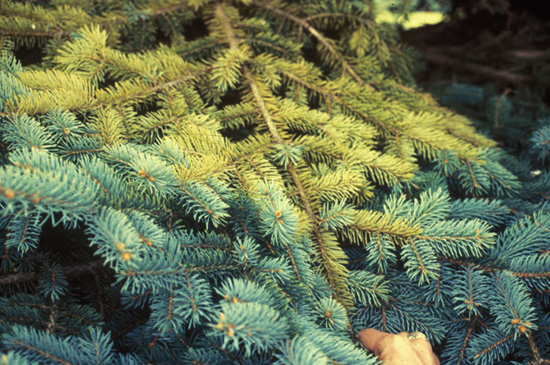Issue 19, November 20, 2009
Yellowed Spruce
Each year at the Plant Clinic we receive a few samples and calls concerning spruces with bright yellow needles. In most cases it is the two or three-year old needles that are yellow, while younger needles are green and apparently healthy. Sometimes the affected needles exhibit yellow banding, but usually entire needles are bright yellow. The image shows a typical sample of this condition.
Being a plant pathologist by training, I tend to assay for foliar pathogens first. The possibilities include Rhizosphaera needle cast (issue #2, 2009), Stigmina (issue #4, 2009), Lirula needle cast (issue #3, 2007), and a little understood disease called SNEED (spruce needle drop). None of these pathogens has been found associated with the bright yellow spruce needles pictured. In fact, I have not associated any fungus with these needles.

Could insects or mites cause these symptoms? Spruce spidermites (issue #1, 2009) may cause the foliage to appear light green from a distance and white-speckled at close range. I have not seen mites or insects associated with this yellowed foliage.
It is a known fact that evergreens drop older needles. Could this be fall needle drop? Although we may see white pines with intense yellowing and drop of two or three-year old needles, that has not been the case with spruces. They typically hold needles for 5-7 years, giving them the dense, attractive appearance we enjoy. Of course, they will not hold needles forever, but inner needles are dropped without turning bright yellow.
Nutrient stress seems to be the general consensus as the cause of this yellowing. One of my colleagues at the Ohio State University said that the symptoms are indicative of a nutritional deficiency, but are not typical of a specific nutrient. I agree. According to Sinclair and Lyon, in Diseases of Trees and Shrubs, 2nd edition, potassium deficiency causes yellowing of older needles and magnesium deficiency can cause premature needle drop. Other sources suggest nitrogen deficiency might cause needle yellowing.
The problem may or may not be an actual lack of nutrients in the soil. Many factors might be limiting nutrient movement to these needles. Root rot, root compaction, waterlogged soil, drainage problems, deep planting, girdling roots, transplant shock, or even high soil pH could be involved. Obviously, the "root" of the problem will vary with each situation. Keep in mind though, injured or rotted roots will not absorb many nutrients.
The first step to management of spruces with these symptoms is to rule out needle pathogens and mites/insects. Next, investigate the condition of roots to determine whether or not that is the main problem. Look at the trunk at this time too, since injuries there could limit water and nutrient movement. If all seems in order, start looking into the nutrient possibilities.
Soil samples from the root area of the tree could be submitted to a soil testing company and assayed for macronutrients and pH. That might be a relatively inexpensive way to establish the need for fertility and to get some recommendations on what is needed. If you suspect salt damage, ask for a soluble salt test at the same time. Foliage can be tested for nutrients as well, but cost should be considered. Foliar sampling is best if done during the growing season and according to the instructions of the testing lab. Usually tip cuttings are requested, but in this case, older tissue might be more useful.
If you have experienced the spruce problem described above, you live in Illinois, and you are willing to share your ultimate diagnosis, drop me a note. My e-mail address is npataky@illinois.edu.--Nancy Pataky
Author:
Nancy Pataky